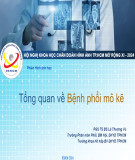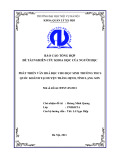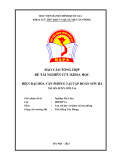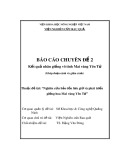
REVIEW Open Access
Cellular kinases incorporated into HIV-1 particles:
passive or active passengers?
Charline Giroud
†
, Nathalie Chazal
†
and Laurence Briant
*
Abstract
Phosphorylation is one of the major mechanisms by which the activities of protein factors can be regulated. Such
regulation impacts multiple key-functions of mammalian cells, including signal transduction, nucleo-cytoplasmic
shuttling, macromolecular complexes assembly, DNA binding and regulation of enzymatic activities to name a few.
To ensure their capacities to replicate and propagate efficiently in their hosts, viruses may rely on the
phosphorylation of viral proteins to assist diverse steps of their life cycle. It has been known for several decades
that particles from diverse virus families contain some protein kinase activity. While large DNA viruses generally
encode for viral kinases, RNA viruses and more precisely retroviruses have acquired the capacity to hijack the
signaling machinery of the host cell and to embark cellular kinases when budding. Such property was
demonstrated for HIV-1 more than a decade ago. This review summarizes the knowledge acquired in the field of
HIV-1-associated kinases and discusses their possible function in the retroviral life cycle.
Review
The genetic information of human immunodeficiency
virus type 1 (HIV-1) is carried by an RNA genome of
approximately 9.3 Kb packaged into viral particles as a
non-covalent dimer [1]. This genetic material contains
nine open reading frames that encode fifteen proteins,
including structural proteins (matrix, capsid, nucleocapsid
and p6), envelope glycoproteins (gp120 and gp41) and
enzymes (protease, reverse transcriptase and integrase).
Six additional open reading frames direct the synthesis of
accessory and regulatory proteins (Tat, Rev, Nef, Vpr, Vpu
and Vif). These proteins have complex functions and gen-
erally interface with the host cell machinery. The mature
structural proteins and enzymes, Vpr, Nef and Vif are con-
tained in a spherical particle surrounded by a lipid bilayer
acquired from the host cell plasma membrane containing
the envelope glycoproteins. Early after HIV-1 discovery,
the particle was also proven to package components from
the host cell. The first studies performed using classical
biochemistry together with more recent analysis relying
on systematic mass spectrometry sequencing have inven-
toried the presence of a wide variety of cellular proteins in
highly purified HIV-1 virions [2,3]. While a fraction have
been reported to be required for viral infectivity, a propor-
tion of these components appear to be non-essential for
replication in a new target cell. The presence of cellular
proteins with varying functional importance in viral parti-
cles may reflect differences in the mechanisms accounting
for the viral incorporation of these host factors. Indeed, at
later replication stages, HIV-1-encoded proteins are direc-
ted to the site of assembly and form a bud consisting of
cellular membranes and cytoplasm. This particular step
favors the passive incorporation into HIV-1 virions of host
cell factors constitutively located at the plasma membrane
or present in the cytosol beneath the budding bilayer.
Alternatively, the budding particle incorporates cellular
factors attracted to the assembly site through specific
interactions with viral components. This last model is par-
ticularly illustrated by the packaging of cofactors assisting
late retroviral replication, including proteins from traffick-
ing systems ensuring targeting of viral proteins and nucleic
acids to the budding site, cofactors required for viral
assembly and cellular complexes involved in the budding
and release of the retroviral particle. An informative
approach to differentiate between these two classes of
virus-associated cell factors was proposed by Hammar-
stedt and Garoff [4]. By measuring the concentrations of
cellular proteins relative to the lipid content in the viral
particles and in the membranes of donor cells expressing
* Correspondence: laurence.briant@cpbs.cnrs.fr
†Contributed equally
Centre d’études d’agents Pathogènes et Biotechnologies pour la Santé
(CPBS), UMR5236 CNRS - Université Montpellier 1-Montpellier 2, Montpellier,
France
Giroud et al.Retrovirology 2011, 8:71
http://www.retrovirology.com/content/8/1/71
© 2011 Giroud et al; licensee BioMed Central Ltd. This is an Open Access article distributed under the terms of the Creative Commons
Attribution License (http://creativecommons.org/licenses/by/2.0), which permits unrestricted use, distribution, and reproduction in
any medium, provided the original work is properly cited.

or not HIV-1 proteins, they discriminated between the
number of factors selectively enriched in the viral particle
and those passively packaged into HIV-1. Using this strat-
egy, the increased concentration of cyclophilin A and
Tsg101 observed at the plasma membrane upon Gag pre-
cursor expression suggested a selective recruitment into
viruses rather than a passive incorporation. On the con-
trary, actin and clathrin appeared to “diffuse”into virions
because their respective concentrations at the membrane
remained unchanged regardless of whether Gag was
expressed. Considering the cellular proteins selectively
attracted into HIV-1 particles through interactions with
viral proteins or nucleic acids, their requirement for pro-
pagation in a new target cell is also variable. Indeed, a
number of packaged cell factors, including those recruited
to support late replication, have been assumed to be non-
essential to the early intracellular steps of replication. Con-
versely, some cellular proteins that have no proven role in
late replication, and are actively recruited into HIV-1, are
strictly required for propagation in a new target cell. A
number of these components have been shown to assist
the intracellular steps of future infectious cycles that are
not fully ensured by the HIV-1-encoded proteins. Encapsi-
dation and subsequent delivery of these proteins to the
target cell are supposed either to compensate for the lack
of essential cellular cofactors or to render them available
at the site which supports replication even if expressed in
the cell. An interesting approach to question the func-
tional importance of packaged cellular proteins is to inves-
tigate their capacity to be incorporated into particles of
HIV-1-related viruses. Comparative studies showed that
several proteins already found to be packaged into HIV-1
particles through specific interactions with viral proteins
or nucleic acids are also detected in HIV-2 and in simian
immunodeficiency virus (SIV) particles (see Table 1 for
references). For some proteins (discussed below), their
conservation was extended to more distant retroviruses,
such as HTLV-1. The significance of such similarities is
questionable. It may be either argued for the conservation
of a common mechanism of replication throughout viral
evolution, or it may be considered as a proof for the non-
specific association of proteins with distantly related
viruses. In a number of cases, including for some kinases,
evidence for the conservation of interaction motives in
viral proteins together with functional studies of viruses
unable to package these cellular factors proved that these
components retain an evolutionarily conserved function
[5-9].
Experimental strategies for the identification of
HIV-1-associated proteins
In addition to the difficulty associated with discriminat-
ing between host factors that are selectively or passively
packaged into viruses, the identification of cellular
proteins embedded in viral particles is technically com-
plicated. The most critical aspect is the strict necessity
to discriminate between virus-incorporated components
and cellular factors contaminating viral preparations.
The latter group includes proteins docked to the outside
of cell-free virions. This group also comprises cellular
proteins contained in microvesicles and exosomes with
sizes and densities comparable to viruses, that co-sedi-
ment with viral preparations and represent a source of
contamination even after the density gradient separation
of viral particles [3,10,11]. Accordingly, sample prepara-
tion should be performed carefully. Two reference pro-
tocols have been developed to produce preparations of
Table 1 Virion-associated cellular proteins in HIV-1, HIV-2
and SIV
Cellular proteins Virus
HIV-
1
HIV-2 SIV
Chaperone Hsp70 +
[32]
+ [32] + [32]
Cyclophilin
A
+
[26]
-
[26,124]
-/+
a
[26,124]
Pin 1 +
[37]
ND +[5]
Cytoskeleton Actin +
[37]
ND +[5]
Moesin +
[37]
ND +[5]
Ezrin +
[37]
ND ND
Arp2/3 +
[37]
ND +[5]
Vacuolar sorting Tsg101 +
[83]
+ [125] ND
Alix +
[84]
ND + [84]
Ubiquitin +
[37]
ND + [126]
Nucleic acids
binding
UNG2 +
[47]
- [127] - [127]
APOBEC3G +
[46]
ND + [128]
Staufen +
[43]
+ [43] + [43]
INI1/HSNF5 +
[42]
- [42] - [42]
Kinases ERK2 +
[6,7]
ND +[5]
PKA +
[14]
ND +[5]
a
incorporated in some SIV strains (SIV
cpz
)
ND: not determined.
Giroud et al. Table 1
Giroud et al.Retrovirology 2011, 8:71
http://www.retrovirology.com/content/8/1/71
Page 2 of 14

highly purified HIV-1 [12]. One approach involves the
digestion of viral samples using the non-specific serine
protease subtilisin. Subtilisin digestion of HIV-1 pre-
parations eliminates more than 95% of the microvesicle-
associated proteins and removes contaminants docked
to the outside of viruses. The effectiveness of this proto-
col is determined by the size reduction of the gp41
transmembrane envelope glycoprotein. This method is
particularly adapted to the study of proteins inside the
virions. Alternatively, CD45 immunoaffinity depletion of
HIV-1 can be used to isolate viruses from cellular exo-
somes. This technique, which was developed based on
the observation that CD45 membrane molecules are dis-
carded from HIV-1 viruses produced from hematopoie-
tic cells [13], has been previously combined with mass
spectrometry analysis to produce an impressive list of
cell factors packaged into HIV-1 particles produced
from primary macrophages [2,3]. CD45 depletion is
most useful for studies that require the exterior of the
virions to be intact. In any case, electron microscopy
imaging provides a reliable method to discriminate
between assembled viruses and exosomes from a mor-
phological point of view and to validate the presence of
host proteins in virions, as previously reported [14].
Another technical feature to consider when studying
HIV-1-associated cellular factors is the cell type and the
viral isolate or strain used to prepare the biological sam-
ples. The array of packaged cellular proteins may differ
greatly according to the host cell used to propagate the
virus. This aspect has been well documented for mem-
brane molecules embedded in the envelope of virions pro-
duced from various T cell lines. The acquisition of CD55
and CD59 complement decay factors [15], LFA-1 [16] and
MHC class I and II molecules [16,17] is host-dependent.
Distinct incorporation profiles have also been reported
when viruses produced from permanent cell lines or pri-
mary peripheral blood mononuclear cells were analyzed
[15,18]. Regarding cytosolic proteins, this point has not
been comprehensively studied. However, LC-MS/MS ana-
lysis of viruses grown on macrophages [3] failed to detect
the presence of some components that were identified
from viruses grown on T lymphocytes. Notably, ERK-2, a
kinase detected from the HIV-1
HZ321
isolate grown in
HUT78 T lymphocytes [6] and from HIV-1
ELI
viruses pre-
pared from MT4 cells [7], was not detected from HIV-
1
NLAD8
grown in primary macrophages [3]. The functional
significance for such difference remains unknown, and its
correlation with the biology of HIV-1 replication in dis-
tinct cell types remains to be analyzed. Nevertheless, the
nature of cellular proteins packaged in HIV-1 needs to be
discussed according to the method in which the viruses
are purified, the nature of the viral strain and the cell type
used for viral production.
Main families of cytoplasmic proteins detected in
HIV-1 virions
The above mentioned strategies have led to the identifi-
cation of a surprisingly large variety of HIV-1 associated
cellular components (referenced in the web-based data-
base http://web.ncifcrf.gov/research/avp/), among which
only a small fraction has been functionally characterized.
A significant proportion of these molecules are glycopro-
teins expressed at the surface of the host cell that become
incorporated into the lipid bilayer surrounding the retro-
viral particle, as extensively reviewed previously [19].
Upon encountering their natural ligand at the surface of
the target cell, they contribute to the initiation and stabi-
lization of the virus-cell contact [20-24], and in some
cases stimulate signaling cascades and various cellular
responses (e.g., inflammation, apoptosis and the modula-
tion of immune responses) [13,25]. Regarding proteins of
cytosolic and nuclear origins, the list of cellular factors
associated with HIV-1 is particularly impressive [3].
Without providing an exhaustive inventory, some
families of proteins have been highlighted.
Cellular chaperones are abundantly incorporated into
HIV-1
The HIV-1-associated protein that was the most exten-
sively studied is certainly the peptidyl-prolyl isomerase
cyclophilin A. Cyclophilin A was detected early as an
essential component for the viral core organization [26].
Approximately 200 molecules are incorporated into one
viral particle, and its interaction with the p24 capsid pro-
tein determines viral infectivity [27,28]. Other proteins
from the chaperone family have been detected in HIV-1
viruses, including heat shock proteins Hsp40, Hsp60,
Hsp90 and Hsp70, and the Pin1 peptidyl-prolyl cis/trans
isomerase [29-31]. The function of HIV-1 associated cha-
perones appears to be generally related to the regulation
of capsid organization, as cyclophilin A, Hsp70 and Pin1
have been proposed to be involved in core reorganization
during assembly and post-entry events [32,33]. This func-
tion is not the only one ascribed to these proteins, parti-
cularly Pin 1. Indeed, Pin1 directly interacts with the
antiviral cytidine deaminase Apobec3G and reduces its
incorporation into viruses [34]. In addition, Pin1 exerts a
stabilizing effect on the retroviral integrase by catalyzing
conformational modifications of the enzyme and pro-
motes HIV-1 genome integration in primary CD4
+
T
lymphocytes [35]. These functions were attributed to
Pin1 in HIV-1 infected cells. Despite the fact that the
contribution of the virus-associated protein in these last
two functions remains to be investigated, it is conceivable
that the presence of Pin1 inside viral particles could assist
early replication by first counteracting residual Apo-
bec3G proteins, which could escape Vif degradation and
Giroud et al.Retrovirology 2011, 8:71
http://www.retrovirology.com/content/8/1/71
Page 3 of 14

be incorporated into HIV-1 and second by stimulating
viral integration.
Proteins from trafficking systems
Proteins participating in the trafficking systems of endo-
genous cargoes are packaged within HIV-1 viruses. This
group includes an important variety of components and
regulators of the cytoskeleton network (actin protein,
Arp2/3, HS-1, ezrin, moesin and cofilin) [28,31,36,37].
This group also comprises components of microtubules
(tubulin subunits and the hexokinase-3 molecular motor
[3]). In addition, a series of proteins that participate in
the vesicular trafficking machinery (Tsg101, Alix, Vps28,
Vps4A, Tal and free ubiquitin) [2,3,38] and host factors
required for vesicular transport (notably LAMP1 and
SNARE) [3] and endocytosis (Rab5a [3], vATPase [3],
and clathrin [39]) are packaged into viruses. The pre-
sence of these components is thought to reflect the
hijacking of the cell trafficking machinery when viral
components are transported to the assembly site. Inter-
estingly, actin and moesin, in addition to unrelated cell-
derived proteins, such as EF-1aand NDR1/2 (discussed
below), have been detected in HIV-1 virions as cleavage
products [31,40]. Experiments conducted using defective
HIV-1 mutants suggested that these proteins are digested
by the retroviral protease. However, the functional signif-
icance for the processing of HIV-1-associated cellular
proteins has not been elucidated.
Nuclear proteins incorporated into HIV-1 particles
The viral incorporation of nuclear proteins is typically
illustrated by the selective packaging of histones (H4,
H2B and H3.1) and a number of proteins that interact
with nucleic acids. This group comprises the active his-
tone deacetylase HDAC1 and the chromatin remodeling
protein INI1/HSNF5, which is selectively incorporated
into HIV-1 virions (but excluded from other retroviral
particles) [41,42]. This group also includes the double-
stranded RNA-binding protein Staufen 1 [43], which sup-
ports viral assembly and is packaged through interactions
with HIV-1 genomic RNA and the nucleocapsid domain
of Gag [44]. Finally, a number of nucleic acid-modifying
and -repairing enzymes are also detected in HIV-1 parti-
cles. The cytidine deaminase Apobec3G is incorporated
into Vif-depleted HIV-1 viruses [45]. In wild-type HIV-1,
the incorporation of Apobec3G is counteracted by Vif
through the help of the proteasome degradation system
[46]. Because Apobec3G has demonstrated anti-viral
effects [46], HIV-1 is thought to have acquired the capa-
city to encode proteins counteracting the incorporation
of cellular factors detrimental to replication when they
are packaged into virions. The packaging of uracil DNA
glycosylase 2 (UNG2), a DNA-repair enzyme required for
the excision of uracil misincorporated into genomic
DNA, also illustrates the capacity of HIV-1 to incorpo-
rate nuclear proteins from the host cell [47]. However,
the function of HIV-1-associated UNG2 remains contro-
versial [48]. This protein was alternatively proposed to
assist the reverse transcriptase and to control uracilation
of the neoysnthesized proviral DNA [49], to be dispensa-
ble for HIV-1 replication [50], or to favor the degradation
of the Apobec3G-edited HIV-1 provirus [51]. Interest-
ingly, expression of cellular UNG2 is dramatically
decreased by HIV-1 Vpr, theoretically preventing UNG2
packaging at high levels [52,53]. As UNG2 was reported
to display antiviral activities [51,53], Vpr-mediated degra-
dation could be considered as a defense mechanism
developed to control activity of an antiviral factor likely
to be incorporated into HIV-1.
Protein kinases packaged into HIV-1
In this review, we focused primarily on the class of HIV-1-
associated host cytosolic factors known as protein kinases.
Phosphorylation is one of the major mechanisms through
which the activity of protein factors can be regulated. In
mammalian cells, up to 30% of all proteins may be modi-
fied by phosphorylation. Such regulation impacts multiple
levels, including nucleo-cytoplasmic shuttling, the assem-
bly of macromolecular complexes, DNA-binding capacity
and enzymatic activation. The presence of kinase activities
in viral particles was observed early. The first observations
in the field demonstrated that high levels of protein kinase
activity are packaged in the Rauscher murine leukemia
virus [54] and vaccinia virus [55], and established that the
product of the transforming Rous sarcoma virus exhibits
phosphotransferase capacities [56]. Since these observa-
tions, widespread interest in the study of virus/kinases
relationships has developed. In a significant number of
models, primarily large DNA viruses (such as Herpesviri-
dae,Poxviridae,Baculoviridae), the phosphorylation of
viral proteins can be catalyzed by protein kinases encoded
by the viral genome. The knowledge in this field has
recently been summarized in a complete review [57].
Regarding HIV-1 and related retroviruses, the viral gen-
ome is devoid of genes encoding protein kinase. The pre-
sence of intraviral kinase activity is strictly related to its
capacity to package cellular enzymes into its particles (see
Table 2). This aspect of HIV-1 biology remains poorly
understood. Indeed, while a significant number of studies
performed during the past decade have determined the
capacity of HIV-1 to activate cellular kinases, particularly
following binding of the viral envelope to its receptors or
subsequently to intracellular replication [58-60], little
attention has been devoted to the characterization of
virus-associated kinases and to the study of their func-
tional roles. To date, a small number of tyrosine or serine-
threonine kinases from cellular origin have been reported
to be embedded in HIV-1. Some have received poor
Giroud et al.Retrovirology 2011, 8:71
http://www.retrovirology.com/content/8/1/71
Page 4 of 14

attention, such as p56
lck
, cdc42, PKC and STAT1 for
which only their presence in the virus has been reported
[3,31]. The kinases that have received the most interest are
ERK2, PKA and NDR1/2 kinases. The knowledge accumu-
lated regarding their functions and their incorporation
into budding structures is discussed below.
ERK2 (HIV-1 produced from lymphoblastoid cell lines;
method of detection: biochemical subtilisin resistance)
The MAPKinase ERK2 was the first protein kinase of cel-
lular origin to be detected within HIV-1 viruses [6,7].
The viral packaging of this protein has been evidenced by
biochemical detection of ERK2 in ultra-purified prepara-
tion of virions and was further confirmed by phosphory-
lation assays performed using a viral lysate as a source of
kinase [6,7]. Its functional role has finally been addressed
by the study of HIV-1 particles produced by cell either
cultured in the presence chemical inhibitors that inter-
fere directly with ERK2 activation or expressing domi-
nant negative forms of ERK2 upstream activators Ras,
Raf or MEK1 [7,61]. This strategy showed that HIV-1
particles devoid of ERK2 activity are poorly infectious.
Such viruses are unable to complete reverse transcription
of the viral genome. They produce reduced levels of
strong-stop DNA, indicating that the virus-associated
kinase is required for an early step of infection. To date,
the exact function of ERK2 packaged in HIV-1 remains
unclear. A number of studies pointed to the capacity of
the kinase to phosphorylate HIV-1 proteins including
Rev [61], Nef [62] and Vif [63,64]. The contribution of
ERK2 in the functional role of Rev and Nef remains
incompletely clarified. Regarding Vif, despite its function
was initially proposed to be regulated by ERK2 mediated
phosphorylation [63], ERK2 has latter been reported to
enhance replication in Vif-independent cell lines [61].
Accordingly, ERK2’s contribution in viral infectivity has
been proposed to be in some extent independent to its
capacity to phosphorylate Vif. Moreover, for all three
proteins, the contribution of the packaged isoform of the
kinase remains far from demonstrated.
Attempts to identify the function of HIV-1-associated
ERK2 have rather focused on its capacity to phosphory-
late the retroviral matrix protein (MA) [7]. A fraction of
MA molecules is phosphorylated in infected cells [65].
Analyzing the functional role of these phosphorylation
events has generated extensive controversy [66-68]. MA
is involved in multiple steps of the HIV-1 replication
cycle. It has been proposed to direct viral proteins traf-
ficking via nuclear import and export functions [69].
More specifically, MA directs targeting of the preintegra-
tion complexes to the nucleus during the early phase of
infection. This function relies on the presence of two
nuclear localization signals in MA [70]. Interestingly, MA
has been reported to localize more predominantly at the
plasma membrane of infected cells when viruses display
reduced ERK2 activity [65]. Consistent with this model,
alanine substitution of four highly conserved serine resi-
dues at positions 9, 67, 72 and 77, which had been identi-
fied as major phosphoacceptor amino acids in MA
(Figure 1), blocked HIV-1 replication at a post-entry step
of infection in permanent cell lines and non-dividing
macrophages [65,71]. The possibility that global MA
phosphorylation unmasks a nuclear localization signal
has been previously proposed for tyrosine phosphoryla-
tion in MA [67]. However, because single serine to ala-
nine substitution of the above mentioned conserved
residues does not markedly influence HIV-1 replication
and has no effect on the MA N-terminal myristate expo-
sure [72], it has rather been suggested that the additive
effect of serine phosphorylation in MA increases the
negative charge of the molecule and promotes the elec-
trostatic repulsion between clusters of positively charged
residues in MA and the inner layer of the plasma mem-
brane [65]. In contradiction with these data, some studies
Table 2 Virion-associated cellular protein kinases and their viral substrates
Family Genus Virus Viral substrate(s) Virus-associated
cellular kinase (s)
Possible function(s) References
Retroviridae Alpharetrovirus AMV (?) 42-46 kDa and 60-64 kDa kinases 10 to 25 kDa viral protein [54,129,130]
RSV (?) Cellular kinase (?) (?) [56]
Betaretrovirus MMTV (?) Cellular kinase (?) (?) [56]
Gammaretrovirus MSV (?) Cellular kinase (?) (?) [131-133]
R-MLV (?) 42-46 kDa and 60-64 kDa Kinases (?) [54,129,130]
FeLV (?) Cellular kinase (?) (?) [56]
Deltaretrovirus HTLV-1 MA ERK2 Virus assembly & release [6,8]
Lentivirus HIV-1 CA, MA, p6 ERK2, PKA, DR1/2, 53 kDa (?), Virus infectivity, uncoating [3,6,7,14,40]
Rev, Nef, Vif p56
lck
, PKC, PRP2, Nm23-H1 Virus release, replication (?) [62-64,82,88,85]
SIV (?) ERK2, PKA, PKC (?) [5,76]
FIV (?) ERK2 (?) [76]
Giroud et al. Table 2
Giroud et al.Retrovirology 2011, 8:71
http://www.retrovirology.com/content/8/1/71
Page 5 of 14

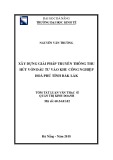


![PET/CT trong ung thư phổi: Báo cáo [Năm]](https://cdn.tailieu.vn/images/document/thumbnail/2024/20240705/sanhobien01/135x160/8121720150427.jpg)
